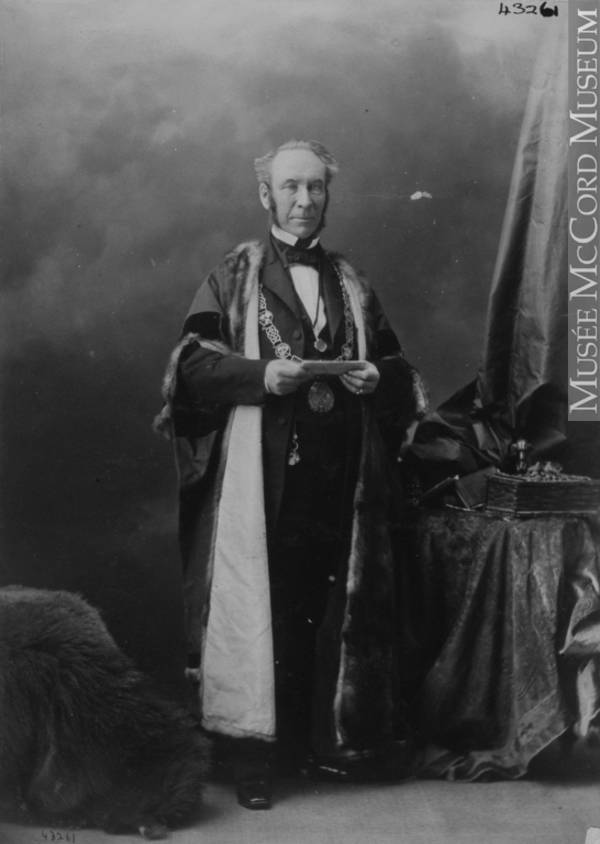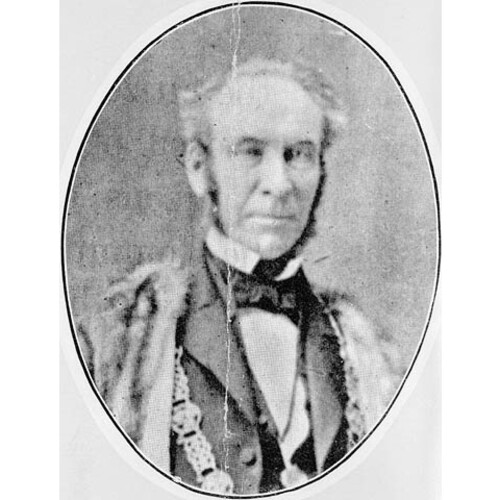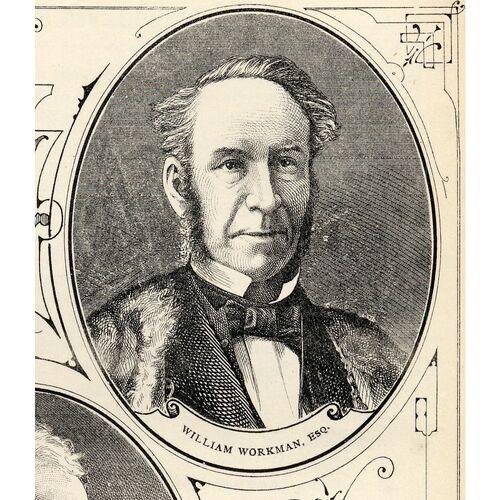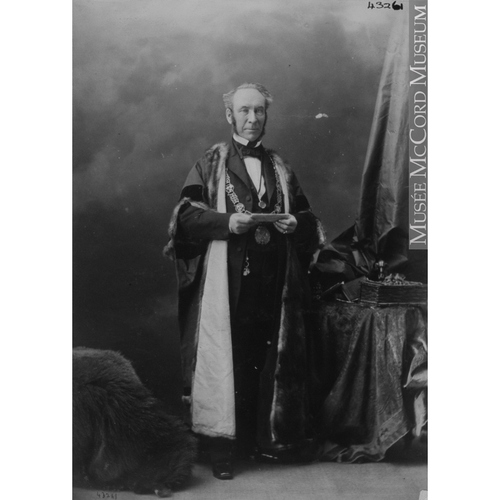
Source: Link
WORKMAN, WILLIAM, merchant, businessman, and mayor of Montreal; b. May 1807, at Ballymacash near Lisburn, County Antrim, Ireland; fifth of nine children of Joseph Workman and Catherine Goudie; d. 23 Feb. 1878 in Montreal, Que.
William Workman was born to a family whose fortunes, once considerable, had apparently declined. There is no evidence concerning William’s schooling; however, he had mastered the skills for employment with the Ordnance Survey of Ireland from 1827 to 1829.
His older brothers, Benjamin, Alexander, Samuel, Thomas*, and Matthew, had left Ireland before the rest of the family set sail for Canada in 1829. Soon after his arrival in Montreal, William was employed by a newspaper, the Canadian Courant and Montreal Advertiser, owned by his brother Benjamin and Nahum Mower. In 1830 William joined brother Thomas in the wholesale hardware house of John Frothingham. The Workmans rose quickly in the firm; by 1836 William and Thomas had become full partners, an indication perhaps that they had brought some capital into the firm. Until his retirement from the concern in 1859, it provided Workman’s business base. As well as handling imported items, Frothingham and Workman manufactured some hardware in their Montreal factories which employed hundreds of men.
Workman did not confine his business interests to hardware, however. He was typical of the Montreal business community of that period in his involvement in ventures stimulated by growth and technological change. The scale of Workman’s speculation in railways, land, and banking is evidence of his wealth by the early 1840s. Among his interests was the City Bank, a Montreal institution of which he was president from 1849 to 1874. His investments in railways included Canada’s first railway, the Champlain and St Lawrence, completed in 1836 to connect Laprairie, on the St Lawrence River opposite Montreal, to Saint-Jean on the Richelieu. This 14-mile railway was designed to facilitate trade between the St Lawrence and the neighbouring states; Workman was one of its directors. Attracted also to the St Lawrence and Atlantic Railroad [see John Young], he was one of the largest shareholders when the line was taken over by the Grand Trunk in 1854. A less successful railway venture was the abortive Montreal and Bytown [see Alexandre-Maurice Delisle].
Workman also invested heavily in Montreal real estate. In the early 1840s he bought a large number of lots in a fashionable west-end residential suburb, where he built his own impressive mansion, Mount Prospect, in 1842. He had considerable property elsewhere in Montreal, and with Delisle bought a sizeable tract on its western outskirts. Workman ventured also into shipping, when in 1854, with Montreal businessmen David Torrance, Andrew Shaw, Ira Gould, and John Kershaw, he established the Canadian Ocean Steam Navigation Company. A year later, Workman purchased two large steamboats for the St Lawrence trade.
Although business was clearly Workman’s major concern for many years, after his retirement from Frothingham and Workman in 1859 he took an active interest in public affairs. As a banker, he combatted the government’s proposed measures to widen its fiscal powers during the late 1860s. In 1866, he attacked Alexander Tilloch Galt*’s recommendations for tariff reductions, “these wild Balaklava dashes at fiscal legislation” which would entail “beggary or emigration” for many Canadians. As a manufacturer, Workman had favoured high protective tariffs since the late 1840s when he led the Association for the Promotion of Canadian Industry. He made no known attempts to enter provincial politics but took an interest in federal affairs after confederation. During the 1870s, perhaps goaded by his brother Thomas’ attachment to the Liberals who, in William’s view, were scented with “a spice of Communism,” Workman wrote occasionally to John A. Macdonald* reminding him of his loyalty and contributions of “the ready” to the party. The letters were little more than importunate pleas for a Senate seat.
Workman was best known in Montreal for his municipal political activity and his local philanthropy. He was nominated for mayor in February 1868 and ran against Jean-Louis Beaudry*, a former incumbent. Workman won the contest easily after overcoming disqualification and serious allegations of corruption levelled against him by his opponent. So popular was he as Montreal’s mayor, that he was returned to the post by acclamation in 1869 and 1870.
Workman was a well-known local figure even before he became mayor. Many years earlier, he had been president of the St Patrick’s Society before it became an exclusively Roman Catholic organization in 1856. Transferring his deep concern for the welfare of the less fortunate to the Irish Protestant Benevolent Society, Workman served it for years, giving money and time to its causes. He helped to establish the Montreal Protestant House of Industry and Refuge in 1864; he served as its president from 1874 to 1877 and left the institution a legacy of $20,000. To encourage thrift and saving among the city’s workingmen, Workman helped to found the Montreal City and District Savings Bank in 1846 [see Marc-Damase Masson]. He was the bank’s first president, 1846–52, and a director, 1861–72.
Workman’s private life was touched with much sorrow. Five children predeceased him and the loss of his only son, at age 24, was especially painful. Throughout most of his adult life, Workman was an adherent of the Unitarian church; he once confided to a friend that, as a Unitarian, he was “accustomed to vituperation from opposing Protestant sects (never from Roman Catholics).” According to one source, he later found solace in Roman Catholicism. He turned increasingly to private worship and had a family chapel added to his large mansion.
PAC, MG 24 B40 (Brown papers), 4, p.778; D16 (Buchanan papers), 63, Workman; MG 26, A (Macdonald papers), 345, pp.158327–30; 346, pp.158526–30; RG 12, AI, 176, pp.137–38. [Bruce and Grey], Elgin-Grey papers (Doughty), IV, 1492. Canada, Province of, Legislative Assembly, Journals, 1851, app.UU, “Proceedings of the standing committee on rail-roads and telegraph lines; together with the minutes of evidence ordered by the committee to be printed”; 1857, app.6, “Report of the special committee appointed to inquire and report as to the condition, management, and prospects of the Grand Trunk Railway Company.” Canada, Province of, Statutes, 1854, c.45. Report of the committee appointed to enquire into the transactions of the Montreal and Bytown Railway Company, prepared by Mr. Loranger, by order of the committee, and unanimously adopted (Toronto, 1856), 51. Gazette (Montreal), 25 Feb. 1878. Montreal Herald, 2 Dec. 1867; 10, 18, 21–23, 25 Jan., 18, 21, 25, 26, 28 Feb., 2 March 1868; 13 Feb. 1869; 13, 14 Feb. 1870. Montreal directory (Mackay), 1845–46, 286; 1852, 353. Borthwick, Montreal, 123. Campbell, Hist. of Scotch Presbyterian Church, 436, 439. T. T. Smyth, The first hundred years; history of the Montreal City and District Savings Bank, 1846–1946 (n.p., n.d.), 22. F. J. Workman, “The Workman family history” (manuscript in the possession of its author). Brian Cahill, “90-year-old papers found in cornerstone,” Gazette (Montreal), 5 July 1955. Allan Cook, “Ancient chapel built here for spite still stands as reminder of bygone feuds,” Montreal Daily Star, 12 Aug. 1937.
Cite This Article
G. Tulchinsky, “WORKMAN, WILLIAM,” in Dictionary of Canadian Biography, vol. 10, University of Toronto/Université Laval, 2003–, accessed December 22, 2025, https://www.biographi.ca/en/bio/workman_william_10E.html.
The citation above shows the format for footnotes and endnotes according to the Chicago manual of style (16th edition). Information to be used in other citation formats:
| Permalink: | https://www.biographi.ca/en/bio/workman_william_10E.html |
| Author of Article: | G. Tulchinsky |
| Title of Article: | WORKMAN, WILLIAM |
| Publication Name: | Dictionary of Canadian Biography, vol. 10 |
| Publisher: | University of Toronto/Université Laval |
| Year of publication: | 1972 |
| Year of revision: | 1972 |
| Access Date: | December 22, 2025 |





